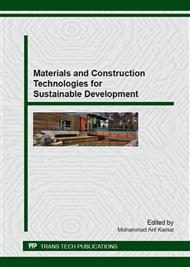[1]
Praseeda, K. I., Monto Mani, and B. V. Reddy. 2014. Assessing Impact of Material Transition and Thermal Comfort Models on Embodied and Operational Energy in Vernacular Dwellings (India)., Energy Procedia 54 : 342-351.
DOI: 10.1016/j.egypro.2014.07.277
Google Scholar
[2]
Bin S, Evans M. Building energy codes in APP Countries. 5th meeting, June 23, 2008, Seoul, Korea. APP Building and Appliances Task Force; (2008).
Google Scholar
[3]
Shnapp, S. and Lausten, J. (2013) Mitigation potential from India's buildings. Paris: Global buildings performance network.
Google Scholar
[4]
Rawal R. et al (2012) Energy Code Enforcement for Beginners: A Tiered Approach to Energy Code in India. In the 2012 ACEEE Summer Study on Energy Efficiency in Buildings. Pacific Grove, California, 2012. Pacific Grove: ACEEE. pp.4313-4324.
DOI: 10.1016/s0301-4215(97)89666-8
Google Scholar
[5]
Menzies, G.F. (2011) Historic Scotland Technical Paper 13. Scotland: Historic Scotland.
Google Scholar
[6]
Chen, T. Y. et al. 2001 Analysis of embodied energy use in the residential building of Hong Kong, Energy, 26, p.323 – 340.
DOI: 10.1016/s0360-5442(01)00006-8
Google Scholar
[7]
Nayak, J. K. and Prajapati, J. A. 2006. Handbook on Energy Conscious Buildings. IIT Bombay and Solar Energy Centre, Ministry of New and Renewable Energy (MNRE), India.
Google Scholar
[8]
Nicol, J. F. and Humphreys, M. A. 2002. Adaptive thermal comfort and sustainable thermal standards for buildings, Energy Build, (34), p.563–572.
DOI: 10.1016/s0378-7788(02)00006-3
Google Scholar
[9]
Moncaster, A. M., & Symons, K. E. 2013. A method and tool for cradle to grave, embodiedcarbon and energy impacts of UK buildings in compliance with the new TC350 standards. Energy and Buildings, 66, 514-523.
DOI: 10.1016/j.enbuild.2013.07.046
Google Scholar
[10]
Hammond, G. P., & Jones, C. I. 2008. Embodied energy and carbon in construction materials, Proceedings of the Institution of Civil Engineers-Energy, 161(2), 87-98.
DOI: 10.1680/ener.2008.161.2.87
Google Scholar
[11]
Reddy, V.B.V., Jagadish, K.S. 2001. Embodied energy of common and alternative building materials and technologies. Energy and Buildings, 35, 129-137.
DOI: 10.1016/s0378-7788(01)00141-4
Google Scholar


